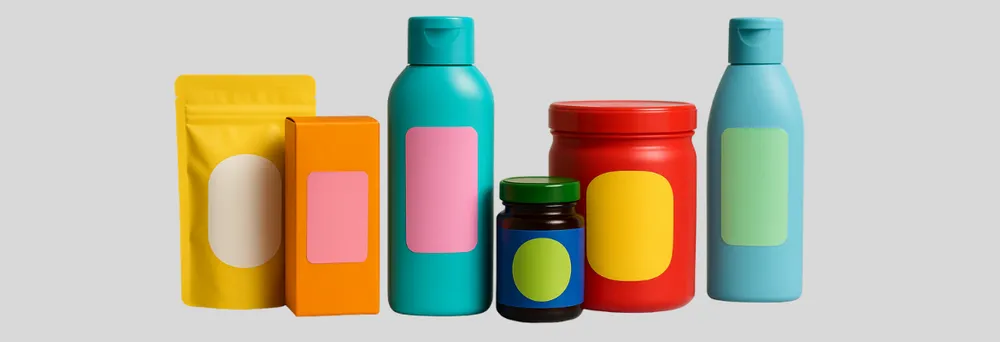
Branding and Marketing with Labels: Enhancing Your Product Identity
- Labels are powerful branding tools that show your company's identity and values
- High-quality, custom labels can greatly increase how well people see and remember your products
- The materials you choose affect both how labels look and how long they last
- Different industries need special label solutions (food, cosmetics, chemicals)
- Smart label design helps your marketing and makes your brand stronger
- Modern printing methods allow for creative finishes like 3D effects and waterproof options
- Eco-friendly labelling solutions are more important for people who care about the environment
- Digital features like QR codes and NFC technology make labels do more
- Good labels balance following rules with attractive visual design
- Measuring how well labels work helps improve marketing impact and value for money
- Seasonal and limited edition labels create excitement and get people interested
- International needs require thinking about different cultures whilst keeping brand consistency

The Power of Labels in Brand Identity
In today's busy marketplace where people see thousands of products every day, having a strong and memorable brand identity is more important than ever before. Labels have grown far beyond just being simple product tags to become powerful marketing tools that tell brand stories, create emotional connections, and help people decide what to buy at the crucial moment when they're shopping. At Labelprint24, we know that in the few seconds people spend looking at products on shop shelves, well-designed labels work as silent brand helpers, instantly showing quality, value, and brand personality through carefully chosen visual elements.
The psychology behind good label design is both interesting and measurable. Research shows that people form first impressions within split seconds of seeing something, making quick judgements about product quality, brand trustworthiness, and personal relevance based only on how packaging looks. Labels work as powerful emotional triggers, with specific colours creating different psychological responses—warm oranges and reds suggest energy and excitement, whilst cool blues and greens show trustworthiness and natural purity. Font choices carry equally strong psychological weight, with traditional fonts showing tradition and reliability, whilst modern clean designs suggest innovation and forward-thinking approaches. These hidden messages happen instantly, often influencing buying decisions before people consciously think about detailed product information.
A well-designed label goes beyond basic product identification to become a compelling storytelling tool that creates emotional connections between brands and customers. Think about how carefully made honey labels can instantly create feelings of natural purity, handmade quality, and wholesome authenticity through smart use of organic images, warm golden colours, and rustic fonts that suggest traditional beekeeping heritage. Similarly, expertly designed gin labels show sophistication, premium quality, and skilled craftsmanship through elegant fonts, sophisticated colour schemes, and refined images that position the spirit as a discerning choice for people who appreciate quality and craftsmanship.
The power of consistent branding across product lines through matching label design cannot be overstated in building market recognition and customer trust. When shoppers can instantly identify your products amongst competing offerings through distinctive visual elements, consistent colour schemes, and recognisable design features, you've achieved the goal of brand recognition—immediate visual distinctiveness that cuts through marketplace noise. This visual consistency creates a unified brand experience that customers recognise, trust, and actively seek out, building loyalty that translates directly into continued sales growth, increased market share, and enhanced customer lifetime value that drives long-term business success.
Smart Label Design for Marketing Impact
Good label design needs a smart approach that carefully balances visual appeal with clear marketing goals, making sure that every visual element serves a specific purpose in telling your brand's value to target audiences. The most successful labels achieve smooth alignment between customer preferences, brand positioning, and practical functionality whilst creating memorable visual experiences that drive both immediate buying decisions and long-term brand loyalty.
When designing labels for maximum marketing impact, successful brands carefully consider these important elements that work together to create compelling visual presentations:

1. Smart Visual Order: Great label design guides the customer's eye through information in a planned sequence, creating a natural visual journey that makes sure the most important elements—brand name, product identity, and unique selling points—are absorbed immediately, even during brief shelf encounters. This order must work well at various viewing distances, from across the aisle to close inspection, making sure that key messages remain clear and compelling regardless of shopping behaviour patterns.
2. Smart Colour Psychology: Colour choices go far beyond visual preference to become powerful psychological tools that influence customer perception and emotional response. Research shows that different colours trigger specific brain responses: green typically suggests naturalness, health, and environmental consciousness, making it particularly effective for organic and wellness products; black often shows luxury, sophistication, and premium positioning, ideal for high-end offerings; whilst bright colours like orange and red create feelings of energy, excitement, and urgency that can drive impulse purchases. Understanding and using these psychological colour associations enables brands to influence customer perception in a planned way.
3. Smart Font Selection: Font choices greatly impact brand perception, readability, and emotional response in ways that go far beyond mere legibility. Traditional serif fonts with their classical finishing strokes show heritage, reliability, and established expertise, making them particularly effective for products emphasising tradition or authority. Modern sans-serif fonts suggest innovation, simplicity, and contemporary relevance, ideal for tech-forward or minimalist brands. The careful selection, sizing, and spacing of fonts creates a smart information order that guides customers through content whilst reinforcing brand personality and market positioning.
4. Compelling Images and Graphics: Visual elements must strategically reinforce brand stories and product features through carefully selected images that connect with target audiences. For cosmetic labels, clean, scientific images might suggest effectiveness, purity, and medical credibility, whilst artistic illustrations might show luxury, indulgence, and sensory pleasure. Each visual element should serve a specific purpose in communicating brand values and product benefits.
5. Smooth Functional Integration: Essential technical elements like barcodes, ingredient lists, regulatory information, and usage instructions must be integrated smoothly into the overall design without compromising visual appeal or brand communication. This integration requires skilled design to maintain regulatory compliance whilst preserving the visual integrity that drives customer appeal and buying decisions.
The most successful label designs achieve the delicate balance between standing out distinctively whilst respecting established category conventions that help customers quickly identify product type and intended use. This smart positioning is particularly crucial in categories with well-established visual languages, where innovation must be balanced with customer expectations and shopping behaviours.
Material Selection: Matching Form to Function
The material foundation of your product labels is equally as important as the design itself, serving as both the physical canvas for your brand expression and the functional foundation that determines durability, visual appeal, and sensory experience throughout the product's lifecycle. Smart material selection directly impacts perceived value, environmental performance, and practical functionality in ways that can greatly influence customer perception and brand success.
At Labelprint24, we offer a wide range of premium materials designed to meet different application needs and brand positioning goals:
Paper-Based Materials:
Premium Standard Paper: Economical yet versatile solution for controlled indoor environments, providing excellent print quality that renders fine details, sharp text, and bright colours with precision whilst offering excellent value for products with standard environmental exposure requirements.
Luxury Textured Papers: Smart tactile elements that enhance premium perception through carefully designed surface textures that create distinctive multi-sensory experiences, encouraging physical interaction whilst raising perceived value and justifying premium pricing strategies.
Sustainable Recycled Paper: Environmentally responsible options that visibly show corporate sustainability commitments, appealing to increasingly eco-conscious customers whilst maintaining excellent printability and visual impact that doesn't compromise brand presentation.
Advanced Film-Based Materials:
Polyethylene (PE) Films: Very flexible and conformable materials specifically designed for irregular or curved surfaces, making them ideal for squeeze bottles, flexible tubes, and other non-rigid containers that need labels to flex repeatedly without wrinkling, cracking, or losing adhesion.
Polypropylene (PP) Films: Superior resistance to moisture, oils, and many chemicals combined with excellent durability, providing outstanding performance for products used in bathrooms, kitchens, or outdoor environments where exposure to various substances and environmental conditions is expected.
Polyvinyl Chloride (PVC) Films: Very durable materials designed for demanding long-term applications, offering superior resistance to abrasion, UV exposure, and extreme temperature changes for products needing extended shelf life or harsh usage conditions.

For products exposed to challenging environmental conditions such as refrigeration, outdoor exposure, or high-humidity environments, special waterproof labels are essential for maintaining brand integrity and information legibility. These advanced labels maintain excellent visual appeal, strong adhesion, and perfect information clarity even in consistently damp or wet conditions, making them essential for bathroom products, outdoor equipment, refrigerated foods, or beverages that experience regular condensation.
The printing method selected also dramatically affects label performance and longevity across different environmental conditions. Thermal transfer printing using special resin ribbons provides excellent durability and resistance to chemicals, solvents, and physical abrasion, making it particularly suitable for industrial applications, laboratory equipment, or any products where labels must withstand harsh handling or environmental exposure whilst maintaining perfect legibility and professional appearance.
When selecting the best materials for your product labels, carefully consider these important performance factors:
- Environmental Exposure: Complete assessment of temperature variations, moisture levels, chemical contact potential, and UV exposure throughout the product's complete lifecycle
- Functional Lifespan: Realistic evaluation of expected label performance duration relative to product usage patterns and replacement cycles
- Sustainability Goals: Alignment with corporate environmental goals and customer expectations regarding eco-friendly packaging and responsible sourcing
- Economic Considerations: Smart balance between material costs, production volumes, brand positioning requirements, and long-term performance expectations
- Brand Positioning: Making sure material choices support and enhance intended brand perception and market positioning strategies
Smart material selection enhances both immediate visual impact and long-term functional performance, contributing greatly to overall brand perception and product experience whilst making sure that your brand presentation remains pristine throughout the product's entire lifecycle.
Industry-Specific Label Solutions
Different industries face unique labelling challenges based on complex regulatory frameworks, specific customer expectations, and practical considerations dictated by product usage environments and market dynamics. Understanding these industry-specific requirements is crucial for creating labels that not only comply with regulatory standards but also enhance brand perception and effectively communicate with target audiences in ways that drive buying decisions and build brand loyalty.
Food and Beverage Labels
Food labels must achieve the complex balance between strict regulatory compliance and compelling design that attracts customers whilst effectively communicating flavour expectations, quality perceptions, and brand values. As a HACCP-audited supplier with extensive experience in food packaging compliance, we make sure that all food labels meet rigorous safety standards and regulatory requirements whilst delivering excellent marketing impact that drives customer preference and buying decisions.
Our special food labels include several important considerations essential for food industry success:
- Advanced Low-Migration Ink Systems: Specially made inks designed to prevent chemical migration to food products, ensuring absolute customer safety whilst maintaining bright colours, sharp details, and long-term visual stability
- Environmental Performance Materials: Special substrates designed to maintain strong adhesion and pristine visual integrity in challenging refrigerated or frozen environments without curling, peeling, colour degradation, or adhesive failure
- Regulatory Compliance Integration: Thoughtfully designed layouts with carefully positioned spaces for mandatory nutritional information, allergen warnings, and regulatory statements that meet complex compliance requirements without compromising brand impact
- Sensory Communication Design: Carefully selected design elements that effectively communicate flavour profiles, ingredient quality, freshness, and core brand values through appropriate colour psychology, image selection, and font choices
For special food products like honey, effective labels often include natural images, warm amber colour palettes, and organic textural elements that emphasise purity, natural origins, and handmade quality that connects with health-conscious customers. Similarly, spirits labels typically feature smart designs with careful attention to detail, elegant fonts, and premium finishing techniques that communicate craftsmanship, heritage, and premium positioning that justifies higher price points.
Chemical and Industrial Labels
Chemical labels prioritise important safety information, complete regulatory compliance, and excellent durability in harsh industrial environments. These special labels must meet several strict requirements essential for worker safety and regulatory compliance:
- International Safety Symbol Integration: Prominent display of internationally recognised hazard symbols and standardised warning information with excellent clarity and visibility, maintaining legibility even after extended exposure to challenging environmental conditions
- Chemical Resistance Engineering: Advanced materials and adhesive systems specifically designed to resist degradation from chemical exposure, including acids, bases, solvents, and other potentially harmful substances that could compromise safety communication
- Durability Performance: Excellent legibility maintenance of important safety information throughout the product's entire lifecycle, withstanding frequent handling, UV exposure, moisture, temperature changes, and industrial cleaning processes
- Global Regulatory Compliance: Full compliance with complex GHS (Globally Harmonised System) standards and other international regulatory frameworks for hazardous materials identification, labelling, and safety communication
Our designed chemical labels withstand exposure to extensive ranges of acids, alkalis, and industrial solvents whilst making sure that important safety information remains clearly visible and perfectly legible under all conditions. For these applications, the primary focus remains on clarity, durability, and complete regulatory compliance, with branding elements thoughtfully integrated without compromising essential safety communication effectiveness.
Cosmetic and Personal Care Labels
Cosmetic and personal care products need smart labels that effectively communicate luxury, effectiveness, and brand positioning whilst providing necessary ingredient information and usage instructions. Our special cosmetic labels include several essential performance features:
- Advanced Adhesive Systems: Designed adhesives made to maintain strong, permanent bonding to various container materials including glass, plastic, and metal surfaces commonly used in cosmetic packaging applications
- Environmental Resistance: Special materials designed to resist oils, moisture, and temperature changes typical in bathroom environments where cosmetic products are stored and used regularly
- Premium Finishing Options: Extensive range of luxury finishing techniques including soft-touch coatings, selective spot varnishes, metallic foil accents, and smart embossing that enhance shelf appeal and communicate premium positioning
- Information Integration: Carefully designed layouts that balance brand impact with clear spaces for ingredient lists, usage instructions, and regulatory information required across different international markets
From functional barcode labels for efficient inventory management and supply chain tracking to primary product labels that drive customer buying decisions, cosmetic packaging needs a smart, coordinated approach to labelling that reinforces brand identity whilst meeting complex international regulatory requirements.
Pharmaceutical and Healthcare Labels
Pharmaceutical and healthcare products need labels that prioritise patient safety, regulatory compliance, and information clarity whilst maintaining professional presentation that builds trust and confidence. These labels must meet very strict requirements:

- Patient Safety Optimisation: Clear, unambiguous presentation of dosage information, contraindications, side effects, and important warnings designed to minimise medication errors and ensure patient safety
- Regulatory Compliance: Full compliance with pharmaceutical labelling regulations including serialisation requirements, batch tracking, and anti-counterfeiting measures mandated by regulatory authorities
- Durability and Legibility: Materials and printing systems that maintain perfect legibility throughout the product's shelf life, including resistance to moisture, temperature variations, and handling
- Security Features: Advanced anti-tampering and authentication features including serialisation, holographic elements, and tamper-evident materials that protect product integrity
Advanced Label Technologies and Finishes
Modern printing and finishing technologies have changed label design possibilities, offering an extensive array of smart finishes, textures, and special effects that can dramatically enhance brand perception, increase shelf impact, and raise product appeal across virtually any category. These advanced technologies enable brands to create distinctive, memorable packaging experiences that drive customer engagement and support premium positioning strategies.
Three-Dimensional and Textured Effects
3D labels with doming effects create striking dimensional appearances that command attention on crowded retail shelves, capturing customer interest through both visual impact and distinctive tactile differentiation. These premium labels feature special clear polyurethane resin applied over printed designs, creating smart magnified, lens-like effects with multiple benefits:
- Enhanced Visual Impact: Dramatically intensifies colour brightness, depth perception, and overall visual appeal, making images and graphics appear more bright, three-dimensional, and engaging than conventional printing technologies can achieve
- Superior Protection: Provides excellent protection against physical abrasion, UV light damage, moisture exposure, and chemical contact, greatly extending the label's visual lifespan even in challenging environmental conditions
- Premium Perception: Creates immediate luxury, high-quality perception that customers instinctively associate with premium products, potentially justifying higher price points and enhancing perceived value propositions
- Multi-Sensory Engagement: Offers distinctive tactile elements that engage multiple customer senses, creating more memorable and engaging product interactions that strengthen brand recall and emotional connection
Beyond full doming effects, smart textured finishes can be achieved through special varnishes, precision micro-embossing, or advanced tactile coatings that add dimensional elements without complete doming. These techniques create interesting textural contrasts and engaging tactile experiences whilst offering various levels of premium finishing to suit different product positioning strategies and budget requirements.
Special Printing Techniques
Beyond standard four-colour process printing, we offer several advanced special techniques that can dramatically raise label design and create distinctive shelf presence that differentiates products in competitive marketplaces:
- Metallic Finishing Systems: Both simulated metallic inks and authentic foil stamping elements that catch and reflect light dynamically, drawing attention and creating premium associations through gold, silver, copper, or smart holographic effects that suggest luxury and excellent craftsmanship
- Selective Spot UV Coating: Precision high-gloss coating applied to specific design elements, creating smart visual and tactile contrast with matte backgrounds that highlights key brand elements whilst adding perceived depth and dimensional interest
- Embossing and Debossing: Raised or recessed elements that add smart tactile interest and dimensional appeal, creating premium feel that encourages customer interaction and suggests careful attention to detail and quality
- Variable Data Printing: Advanced digital printing technology enabling personalisation, sequential numbering, or batch-specific information, facilitating customisation at production scale without sacrificing efficiency or quality consistency
These smart techniques can be carefully combined to create truly unique, multi-dimensional labels that command attention, communicate premium positioning, and create memorable brand experiences that justify higher price points and distinguish products within competitive categories.
Smart Label Technologies
The rapidly evolving future of product labelling increasingly includes interactive elements that extend functionality beyond static visual appeal, creating new opportunities for customer engagement, brand storytelling, and enhanced product functionality:
- QR Code Integration: Scannable codes that instantly connect customers to websites, videos, authentication systems, or detailed product information, extending the label's informational capacity whilst creating valuable digital engagement opportunities and data collection possibilities
- NFC Technology: Near-field communication technology enabling smart tap-to-interact experiences with smartphones, allowing product authentication, loyalty programme integration, or access to exclusive digital content without requiring visible code space or design compromise
- Temperature Indication: Colour-changing elements that visually show if temperature-sensitive products have been stored properly, adding functional value whilst showing brand commitment to product quality and customer safety
- Augmented Reality Integration: Hidden or integrated visual triggers that launch immersive digital experiences when scanned with smartphone applications, creating engaging brand storytelling opportunities that extend far beyond physical packaging limitations
These innovative technologies transform labels from passive design elements into active marketing tools that engage customers, provide valuable functionality, and extend brand relationships beyond the physical product itself, creating opportunities for ongoing engagement and enhanced customer experiences.
Packaging Integration: Beyond the Label
Whilst labels themselves are powerful branding tools, their maximum effectiveness is achieved when thoughtfully integrated with complete packaging strategies. The relationship between labels and their packaging containers creates coordinated, unified brand experiences that connect more deeply with customers than either element could achieve independently, resulting in stronger brand recognition, enhanced perceived value, and increased customer preference.
Matching Labels with Packaging
The most effective branding strategies make sure that labels complement and enhance packaging containers across several important dimensions that work together to create unified brand experiences:
- Size and Proportion Optimisation: Labels must be precisely sized and positioned to fit naturally and attractively on containers, maximising visibility of key information whilst maintaining visual balance and visual harmony with overall package geometry and proportions
- Material Compatibility Assurance: Label materials must be carefully selected to adhere properly to specific packaging surfaces (glass, plastic, metal, etc.) and withstand identical environmental conditions throughout the complete product lifecycle without degradation, delamination, or performance failure
- Visual Design Continuity: Design elements, colour schemes, and graphic features should flow naturally and consistently between packaging structure and label elements, creating unified visual presentations rather than disconnected, competing components
- Functional Integration: Labels should enhance rather than interfere with packaging's practical usability, considering factors like container handling, dispensing mechanisms, storage requirements, and customer interaction patterns
For example, folding boxes with security tabs can include label elements directly into printed structural design, creating smooth, integrated appearances that enhance brand coordination whilst providing functional benefits. Similarly, stand-up pouches might use labels as planned accent elements that complement primary printed designs whilst providing additional information or highlighting specific product features that drive customer interest and differentiation.
Sustainable Packaging and Labelling
As environmental concerns increasingly influence customer buying decisions and corporate responsibility initiatives, brands are seeking complete sustainable packaging solutions that address entire product container ecosystems. Labels play important roles in these holistic eco-friendly approaches:
- Recyclability Compatibility: Labels designed specifically not to interfere with primary packaging recyclability, using compatible adhesives and materials that don't contaminate recycling streams or require complex separation processes
- Biodegradable Systems: Special adhesives made to ensure labels don't prevent proper composting or biodegradation of environmentally friendly packaging materials, maintaining complete end-of-life sustainability
- Material Reduction: Thoughtful minimalist design approaches that use fewer materials without sacrificing brand impact or essential information clarity, reducing overall environmental footprint whilst maintaining full functionality
- Environmental Communication: Clear, credible messaging about sustainability commitments through standardised certification symbols, recycling instructions, and environmental impact information that educates and engages environmentally conscious customers

By integrating labels with packaging through complete sustainability approaches, brands can create coordinated, environmentally responsible presentations that connect with eco-conscious customers whilst showing authentic corporate environmental values that build trust, loyalty, and positive brand associations.
Label Customisation for Market Differentiation
In today's busy marketplace where customers face overwhelming product choices across every category, planned customisation has become essential for creating distinctive brand identities that connect with target audiences and drive preference. Custom-designed labels provide brands with powerful opportunities to create unique visual identities that differentiate products, communicate specific value propositions, and build emotional connections with customers in ways that generic, template-based solutions simply cannot achieve.
Cultural and Regional Adaptation
As explored in our complete article on designing labels for British brands, cultural context greatly influences effective label design in ways that can dramatically impact customer response and market acceptance. Different geographic markets have unique characteristics that must be carefully considered for best performance:
- Colour Psychology Variations: Distinct colour associations and preferences that vary greatly between cultures, with colours carrying different symbolic meanings, emotional responses, and cultural significance across different regions and demographic groups
- Design Visual Preferences: Regional design visuals and style expectations that reflect local artistic traditions, historical influences, contemporary visual trends, and cultural values that connect with specific populations
- Regulatory Compliance Requirements: Varying regulatory requirements for information display, including language requirements, measurement systems, mandatory warning statements, and certification marks that differ across jurisdictions
- Cultural Symbol Interpretation: Cultural symbols and image interpretations that can differ dramatically between regions, potentially creating unintended associations, misunderstandings, or negative responses if not properly researched and validated
For brands operating across multiple international markets, planned label customisation involves adapting designs to connect with local customers whilst maintaining consistent core brand identity elements that ensure global recognition and brand equity preservation. This smart localisation strategy can greatly impact customer acceptance, cultural relevance, and market penetration success in diverse geographic regions.
Seasonal and Limited Edition Labels
Temporary label variations create excitement, collectibility, and buying urgency that drives customer engagement and buying motivation whilst providing opportunities for creative expression and market testing:
- Seasonal Design Programmes: Thoughtfully crafted holiday themes or seasonal images that create timely relevance and emotional connections with customers during specific periods, encouraging seasonal buying behaviour and gift-giving occasions
- Limited Edition Releases: Special designs produced in finite quantities that generate scarcity and urgency, encouraging immediate buying decisions whilst creating collectible appeal that drives customer excitement and brand engagement
- Collaborative Design Partnerships: Creative alliances with artists, designers, or complementary brands that generate unique visual appeal and cross-promotional opportunities that reach new audience segments whilst adding creative credibility
- Milestone Commemoration Editions: Celebratory designs commemorating company anniversaries or significant milestones with retrospective elements that highlight heritage and longevity, building trust through demonstrated market permanence and brand stability
These planned limited-time label variations can generate valuable social media engagement, encourage repeat purchases through collectibility appeal, and strengthen emotional connections with customers who appreciate novelty and exclusivity. They're particularly effective for products with frequent buying cycles, creating compelling reasons for customers to return repeatedly to discover new offerings.
Personalisation and Variable Data
Modern digital printing technology enables smart personalisation at production scale that was previously impossible or prohibitively expensive, opening new opportunities for customer engagement and brand differentiation:
- Individual Personalisation: Including customer names or personalised messages that create unique emotional connections and premium gift-giving opportunities, as shown by highly successful campaigns that have generated significant customer engagement and social media sharing
- Regional Market Variations: Implementing subtle design adaptations for different geographic markets that acknowledge local preferences, cultural nuances, and market characteristics whilst maintaining overall brand consistency across product lines
- Batch-Specific Highlighting: Emphasising unique characteristics of specific production runs, particularly valuable for handmade products like craft beverages where batch variation represents authenticity and craftsmanship rather than quality inconsistency
- Event-Specific Customisation: Creating custom designs for weddings, corporate events, or promotional opportunities that transform products into memorable keepsakes or branded experiences that extend brand engagement beyond typical consumption
Personalised labels create powerful senses of exclusivity and individual attention that customers increasingly value in today's mass-production marketplace, often justifying premium pricing whilst generating valuable word-of-mouth marketing as recipients share their personalised products through social media and personal networks.
Regulatory Compliance and Information Requirements
Whilst creative design elements are essential for brand differentiation and customer appeal, labels must at the same time fulfil important informational and regulatory functions that ensure customer safety, legal compliance, and market access. Balancing these sometimes competing requirements with compelling branding elements represents one of the most significant challenges in effective label design across virtually all product categories, requiring skilled design skills and complete regulatory knowledge.
Industry-Specific Regulatory Frameworks
Different product categories face distinct, often complex labelling requirements imposed by regulatory authorities that must be carefully followed for market access and customer safety:
- Food and Beverage Requirements: Complete nutritional information panels, allergen warnings with specific formatting requirements, complete ingredient lists in descending order, country of origin labelling, net quantity statements meeting precise measurement standards, and claims substantiation documentation
- Pharmaceutical Regulations: Detailed drug facts, precise dosage information, explicit warning statements, active and inactive ingredient listings, expiration dating, lot numbers, storage instructions, and patient safety information that ensures proper usage and prevents medication errors
- Chemical Safety Standards: Internationally standardised hazard symbols, detailed safety information, first aid instructions, precautionary statements, ingredient disclosure, and handling information that meets global regulatory frameworks and ensures worker and customer safety
- Cosmetic Compliance: Complete ingredient lists using INCI nomenclature, usage instructions, volume/weight information, shelf life indicators, country-specific regulatory symbols, registration numbers, and claims substantiation for marketing statements
Our special chemical labels are designed to display all required hazard information according to GHS standards whilst maintaining essential brand identity elements that ensure recognition and professional presentation. Similarly, our food labels make sure that mandatory nutritional information is presented with excellent clarity and regulatory accuracy without compromising the visual appeal that drives customer interest and buying decisions.
Smart Integration of Compliance with Design
Successful label design thoughtfully includes regulatory elements in ways that feel natural and visually coordinated whilst ensuring complete compliance with all applicable standards:
- Smart Layout Architecture: Carefully positioning required elements to support logical visual hierarchy whilst meeting specific regulatory placement requirements, creating natural information flow that guides customers through essential content
- Font Strategy: Selecting fonts and establishing size relationships that ensure perfect readability of important information whilst maintaining brand character through complementary font families and hierarchical systems
- Colour Coding Systems: Using colour carefully to highlight important warnings or instructions whilst integrating these colours smoothly within overall brand palettes and visual identity systems
- Branded Icon Development: Creating custom icons that convey required information in brand-consistent visual language whilst meeting regulatory recognition standards and customer comprehension requirements
By approaching regulatory elements as integral design components rather than afterthoughts, brands can create labels that satisfy compliance requirements whilst presenting visually appealing, coordinated designs that effectively communicate brand values and product benefits to target audiences.
International Compliance Considerations
For products marketed across multiple countries or regions, labels must accommodate complex international requirements that add significant design challenges whilst maintaining brand consistency:
- Multi-Language Requirements: Multiple languages presented with equal prominence in markets with linguistic diversity or bilingual requirements, requiring smart space management and font solutions
- Regional Regulatory Variations: Different regulatory symbols and warning statements that vary by jurisdiction but must all be included for multi-market distribution, necessitating creative integration solutions
- Information Priority Differences: Varying information display priorities where certain elements must appear more prominently in some markets than others, requiring flexible design architectures
- Certification Mark Requirements: Country-specific certification marks, recycling symbols, or compliance indicators that must be included without disrupting overall design harmony and brand presentation
These international regulatory complexities create significant design challenges but also present opportunities for creative solutions that work effectively across borders whilst respecting local regulations and cultural preferences. Innovative approaches like multi-panel labels, peel-back information layers, or market-specific packaging variations can help brands navigate complex requirements whilst maintaining brand consistency and visual appeal.
Strategic Label Application for Different Product Types
The physical application method and placement of labels varies greatly across different product types and container formats, with each presenting unique technical challenges and branding opportunities that must be carefully considered during both design and production phases to ensure the best visual results, functional performance, and brand presentation.
Container-Specific Design Considerations
As explored in our complete article on packaging materials and their applications, different container types present specific labelling challenges that need tailored approaches and special solutions:
- Curved Surface Applications: Bottles and jars with curved surfaces needing highly flexible label materials or specially shaped die-cut labels that conform perfectly to container curves without wrinkling, bubbling, or lifting at edges during application and throughout product lifecycle
- Flat Surface Optimisation: Boxes and cartons with flat surfaces allowing for larger, more detailed designs with excellent printability, though corner wrapping and edge adhesion must be carefully designed for long-term durability and professional appearance
- Flexible Packaging Adaptation: Materials that can stretch and flex with packaging substrates without cracking, distorting designs, or losing adhesion, maintaining visual integrity even as packages change shape during handling and use
- Irregular Container Solutions: Special conformable label materials or segmented label designs that adapt to unique product geometries whilst maintaining consistent brand presentation across unusual or complex surfaces
Container base materials greatly impact label selection decisions, as glass, various plastics, metal, and cardboard each interact differently with adhesive systems and present different visual backgrounds that affect colour perception, design impact, and long-term performance. These substrate characteristics must be carefully evaluated during both design development and material specification phases.
Application Methods and Production Considerations
The method used to apply labels affects both visual outcomes and production efficiency, with important implications for brand presentation consistency and manufacturing scalability:
- Manual Application: Suitable for small production batches, handmade products, or highly irregular containers where human judgement improves placement accuracy, though consistency can vary between operators and production speeds are limited
- Semi-Automatic Systems: Effectively balance improved efficiency with flexibility for different container shapes, offering good consistency whilst accommodating moderate production volumes and various product configurations
- Fully Automated High-Speed Application: Ensures perfect consistency at high production volumes with excellent speed and precision, though requires standardised containers and label designs optimised for machine application specifications
- Direct Printing Technologies: Eliminate separate labels entirely by printing directly on packaging substrates, offering smooth integration and reduced material usage though limiting substrate material options and design flexibility
For brands transitioning from small-scale manual production to larger automated processes as they scale, label designs may need evolution to accommodate technical requirements of application machinery whilst maintaining brand consistency and visual impact throughout the transition.
Multi-Part Labelling Systems
Complex products often benefit from smart coordinated label systems that address multiple information needs whilst maintaining coordinated brand presentation:
- Primary and Secondary Label Coordination: Carefully dividing information between front and back labels, allowing primary display panels to focus on brand impact whilst secondary panels contain detailed regulatory or instructional information
- Layered Information Systems: Base labels with information overlays allowing for expanded content presentation in limited space, particularly useful for products needing extensive instructions or multilingual content requirements
- Interactive Reveal Systems: Innovative peel-and-reveal designs providing additional information under top layers that customers can lift to discover more content, creating engagement whilst maximising available information space
- Cross-Container Brand Systems: Visually connected designs across product families that create brand recognition whilst adapting to different container shapes, sizes, and functional requirements
These smart multi-part systems can effectively solve complex information challenges whilst creating distinctive, engaging brand presentations that invite customer interaction and transform regulatory requirements into opportunities for brand differentiation.
Measuring Label Marketing Effectiveness
To maximise return on investment and continuously improve brand performance, companies must implement systematic methods to measure how label designs impact marketing outcomes and influence customer behaviour throughout the complete buying journey and product usage experience. Effective measurement provides actionable insights that drive continuous improvement and best resource allocation.
Key Performance Indicators
Several specific metrics can help objectively evaluate label effectiveness and quantify return on design investment across multiple dimensions of marketing performance:
- Sales Performance Analysis: Rigorous before-and-after sales analysis when labels are updated or redesigned, isolating the label change as a variable whilst controlling for other marketing factors to measure direct impact on buying behaviour and revenue generation
- Brand Recognition Studies: Formal brand recognition and recall studies measuring how quickly and accurately customers can identify products based on label design elements, even when brand names are obscured or competitive products are present
- Shelf Impact Assessment: Smart eye-tracking studies showing precisely how labels attract attention in competitive retail environments, measuring factors like time to first fixation, viewing duration, and visual hierarchy effectiveness
- Digital Engagement Metrics: Analysis of social media appearance frequency and sentiment when products appear in customer-generated content, indicating which packaging designs inspire sharing, positive commentary, and organic brand advocacy
As discussed in our complete article on customising shipping cartons, even secondary packaging and transit materials present significant opportunities for brand reinforcement and customer impression formation that can be measured and optimised to extend brand impact beyond primary packaging touchpoints.
Advanced Testing and Optimisation
Methodical, controlled testing can reveal precisely which label elements most effectively drive positive customer response and buying behaviour, enabling data-driven design decisions:
- Smart Colour Testing: Testing different colour schemes whilst maintaining all other design elements constant, allowing for precise measurement of colour impact on customer perception, emotional response, and buying intent across different demographic segments
- Font Effectiveness Analysis: Evaluating the impact of different font choices, weights, and hierarchies on readability, emotional response, brand perception, and buying intent through controlled comparison studies
- Layout Optimisation Studies: Carefully modifying visual hierarchy to emphasise different product features or brand elements, determining which information priorities most effectively drive buying decisions and brand recall
- Material and Finish Impact Assessment: Objectively assessing customer preference and perceived value associations for different substrate materials, textures, and finishing techniques through controlled tactile and visual comparison testing
For products with frequent production cycles or high unit volumes, implementing ongoing optimisation through systematic testing can lead to significant improvements in market performance over time, with even small percentage gains translating to substantial revenue impact at scale.
Customer Journey Analytics
Understanding how labels perform across the complete customer journey provides complete insights for optimisation:
- Awareness Stage Impact: Measuring how labels perform in creating initial brand awareness and product recognition through various marketing channels and touchpoints
- Consideration Phase Influence: Analysing how label design elements influence product evaluation and comparison behaviours during the consideration process
- Purchase Decision Drivers: Identifying specific label elements that most effectively drive final buying decisions at the point of sale
- Post-Purchase Satisfaction: Evaluating how label design contributes to overall product satisfaction, brand perception, and likelihood of repeat purchase or recommendation
Future Trends in Label Marketing
The labelling industry continues to evolve rapidly, driven by technological advancement, changing customer expectations, environmental consciousness, and digital integration that creates new opportunities for brand engagement and customer connection.
Sustainability and Eco-Innovation
Environmental considerations are increasingly driving label innovation and customer preference:

- Biodegradable Materials: Advanced substrate materials that decompose naturally without environmental harm, meeting customer expectations for sustainable packaging solutions
- Recyclable Integration: Label designs and materials that facilitate rather than hinder packaging recyclability, supporting circular economy principles
- Carbon Footprint Reduction: Local production capabilities and efficient manufacturing processes that minimise transportation and environmental impact
- Sustainable Messaging: Clear communication of environmental benefits and corporate sustainability commitments through label design and content
Digital Integration and Smart Packaging
Technology integration continues to expand label functionality and customer engagement opportunities:
- IoT Integration: Internet of Things connectivity enabling real-time product monitoring, usage tracking, and customer engagement
- Blockchain Authentication: Unchangeable product verification systems that prevent counterfeiting whilst providing transparency
- Dynamic Content: Labels that can update information or change appearance based on environmental conditions or customer interaction
- AI-Driven Personalisation: Machine learning systems that enable mass personalisation based on customer preferences and behaviour patterns
Enhanced Customer Experience
Future label innovations focus on creating more engaging, informative, and interactive customer experiences:
- Multi-Sensory Design: Labels that engage multiple senses through texture, scent, or even sound to create memorable brand experiences
- Adaptive Information: Context-sensitive labels that provide different information based on user needs, location, or time of day
- Gamification Elements: Interactive features that turn product packaging into engaging experiences that build brand loyalty
- Community Building: Labels that connect customers with brand communities and user-generated content platforms
Conclusion: Maximising Brand Impact Through Smart Label Design
In an increasingly competitive marketplace where customer attention is fragmented and brand loyalty is constantly challenged, labels represent one of the most powerful and cost-effective tools for building brand recognition, communicating value propositions, and driving buying decisions. The importance of expertly designed labels extends far beyond visual appeal to encompass customer psychology, regulatory compliance, sustainability considerations, and technological innovation that collectively create complete brand experiences.
Successful label design requires smart integration of multiple disciplines: visual design that captures attention and communicates brand values, materials science that ensures durability and environmental performance, regulatory expertise that maintains compliance across multiple markets, production knowledge that enables efficient manufacturing, and marketing strategy that drives customer engagement and buying behaviour. This multidisciplinary approach ensures that labels function as integrated marketing tools that support broader business objectives whilst delivering excellent return on investment.
At Labelprint24, we understand that effective labels represent the convergence of art and science, creativity and compliance, innovation and practicality. Our complete approach combines deep industry expertise, advanced manufacturing capabilities, creative design excellence, and ongoing innovation to deliver label solutions that not only meet immediate needs but anticipate future requirements and opportunities. Whether you're launching a new product, refreshing an existing brand, expanding into new markets, or seeking to differentiate your offerings in competitive categories, our team of experts is equipped to help you leverage the full potential of smart label design.
The future of label marketing promises continued evolution driven by technological advancement, environmental consciousness, and changing customer expectations. Brands that embrace these trends whilst maintaining focus on fundamental design principles and smart marketing objectives will be best positioned to succeed in tomorrow's marketplace. By partnering with experienced professionals who understand both current best practices and emerging opportunities, businesses can ensure their label investments deliver maximum impact and long-term value.
Contact Labelprint24 today to discover how smart label design can enhance your brand identity, drive customer engagement, and support your business growth objectives in an increasingly competitive global marketplace.




